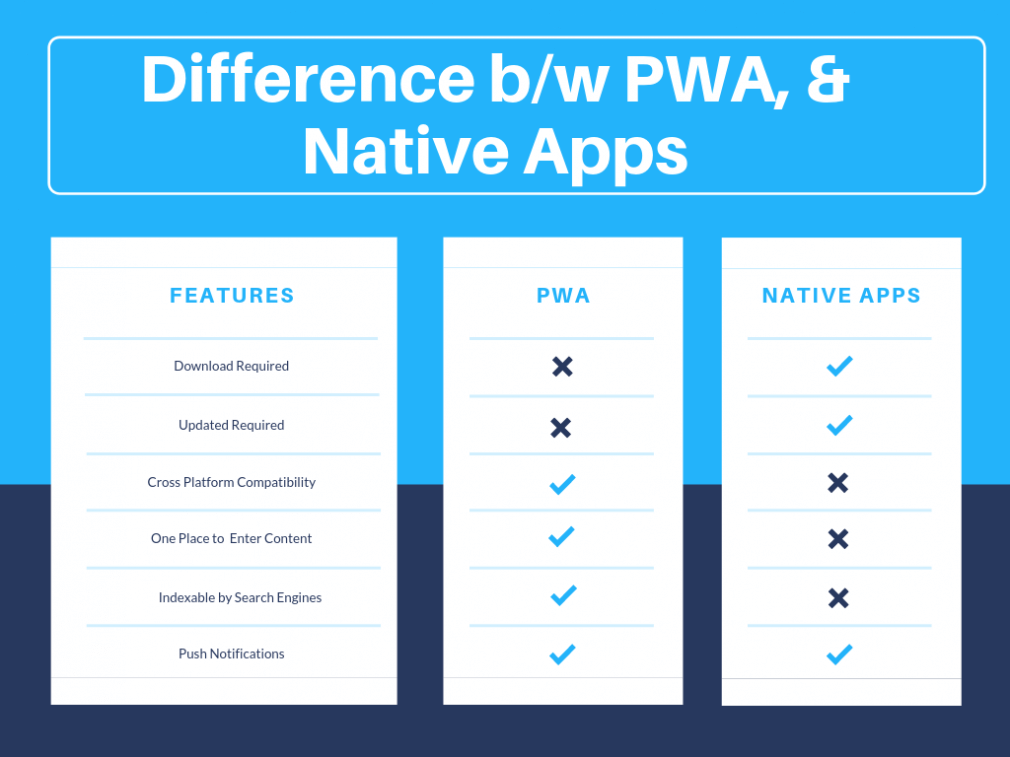The number of smartphone consumers has been developing consistently and so has online shopping. To satisfy modern clients' needs, ecommerce entrepreneurs need to give a quick, simple, consistent and smooth mobile shopping experience. That is where mobile app development comes into the picture. This has become an integral part of every mobile app development company which helps in delivering a great experience and good results.
However, which would it be advisable for you to pick: a native app or a progressive web app? To settle on an informed decision, you'll initially have to know the features and differences between a progressive web app or a native app. We have written this article to simplify the differences between PWAs and native apps and how organizations can profit from each.
A progressive web app behaves like a native mobile application. The fundamental comparison between a PWA and native mobile application is that PWA works in a program, so there's no compelling reason to download it from an application store. PWAs can save information on a client's device as a cache. That permits clients to keep up with every new update, regardless of how quick their internet connection is.

PWA goes by the Progressive enhancement principle that provides basic functionality and content to everyone without considering the connection quality and browser compatibility while delivering more sophisticated page versions to users.
PWAs can function on low-quality networks or no network at all.
The App-like interface of PWAs helps to mimic navigation and interactions of native applications.
Push notifications are generally used as a messaging strategy, to keep customers interested, and motivate them to use the application more and more.
The applications self-update themselves automatically, helping every Progressive web app development company to stay up to date with the latest versions.
These apps have high security to deny access to unauthorized users as they are served through HTTPS.
PWAs are not distributed via app stores and are shared through a URL to be discovered easily.
PWAs have simple installation that entails visiting a site by adding it to a device home screen.
Native mobile apps on the other hand are created to work ideally on either iOS or Android. In this manner, a native application can utilize the full scope of usefulness a device offers. Unlike PWA, Native app users will need to download the mobile application from Playstore to start using it. PWAs overlook this step, however, they don't have some special components for iOS users.

Native apps are shielded by different layers of an OS, which makes them difficult to abuse. They don't depend on any third-party system,utilizing simply official APIs that have been entirely analyzed across various framework versions.
Maintenance of a native app is a bit complicated, nonetheless, clients can get data about the latest update effortlessly.
Native applications are faster, more responsive, and offer a noteworthy client experience. These applications work faster since they are written in languages explicit to the ecosystem of the system.
Using native app development, you have less dependence for bugs to happen as you will not rely upon a cross-platform tool like Xamarin or Cordova.
Going native is the most ideal choice in case there is no network. Organizers, coordinators, guides and even games can perform offline since their content is downloadable.

Building a progressive web app is less expensive than building a native application. You can have one single codebase for different platforms. So rather than developing an application right from the beginning you can arrange your current website with assistance from tools like Google Lighthouse.
Native apps as opposed to PWAs, you should get familiar with the language and create a new rendition for every stage. This implies you need no less than two variants for iOS and Android, and the resources to keep up with and update each of them. Depending upon the reason and intricacy of the application, this requires a great deal of time and money.
Another difference between Progressive Web app vs native app is that Native app pages cannot be indexed and listed in the search engine. Users can find your app through the app store or the app store’s website. There are a number of factors influencing app discoverability, and you can help people find your app faster with App Store Optimization (ASO).
Native application pages can't be filed and recorded in the web index. Clients can discover your application through the application store or the application store's site. There are various components affecting application discoverability, and you can assist people with finding your application quicker with App Store Optimization (ASO) that helps in increasing your position in in-store search results.
Progressive web app, on the other hand, works like any site so it tends to be listed in web indexes. Compared to responsive web pages, PWA has expanded in terms of performance and commitment, helping your site rank better in search results.
PWAs are safer than ordinary web applications since they need to run under HTTPS.
These security conventions guarantee that no trades between the server and the client are altered. In a safe environment, clients can enter individual details and Mastercard data without the concern they may be taken.
Compared to PWA vs native apps, you have the choice to work in numerous safety parameters. If your application requires login, you can execute it through Multi-Factor Authentication. You can also utilize Certificate pinning to communicate securely. Also, clients are bound to trust an application more than a URL, as it needs to pass the App Store's security prerequisites prior to getting published.

In comparison with Progressive web apps vs native apps, PWAs will definitely have an upper hand on this. For Native apps users will have to locate the application in the store and affirm that they need to install it. Post that they need to sit tight for the download and installation. After getting granted for the certain permissions, they utilize the application perhaps on more than one occasion before deleting them.
When clients uninstall an application, it is generally an official decision and they probably won't return. Progressive web apps as compared to Native apps on the other hand require no such App Store or installation. From the browser, users can bookmark and add the application with a couple of taps to their home screen. The PWA will appear on the home screen, in their application registry, and coordinate into framework settings.
Another difference between PWAs and Native apps is that a PWA can serve certain pieces of the application to clients when their device can't interface with an organization. In any case, a PWA can't serve all pieces of the application to them; explicitly, anything that isn't important for the page's regular caching framework will be disconnected until the network is reestablished. In this way, assuming a client needed to present a contact form to Forbes or reserve a spot on Trivago, they'd not be able to do as such.
Native applications certainly win in this class. While it's incredible that the innovation of PWAs is making up for lost time and permitting clients to get to stored content, they're simply not exactly at the point in having the option to take advantage of a point phone to remain connected regardless.
Since engineers for the most part plan an application explicitly for iOS or Android clients, this guarantees that the experience inside the native application is customized to every platform. Developers need to stress less over cross-platform or browser compatibility and more on forming their application for one explicit cell phone.
Progressive web applications compared to Native apps, by and large, adopt an alternate strategy. Developers make the responsive example of the PWA, publish it, and afterward pass on it to the client's program to show it effectively inside the screen's parameters. It's only one application to create and clients across a wide scope of mobile browsers can engage in with the application because of current web technologies.

Compared with a responsive or mobile site, PWA loads a lot quicker. At the core of any PWA is service workers, scripts that run the foundation and separate from the website page. With service workers, you can handle all sorts of offline requests, prefetch, and store certain resources, sync information with a distant worker, and there are many more.
This implies that after adding your application to the home screen, you can load it in a split second and use it offline or in bad network areas. Additionally, PWA runs from a browser, implying that there will be slow response time and more battery utilization than the native application.
Native apps compared to PWAs can integrate with the fundamental operating framework. It can access device equipment to accomplish more computations and convey a superior experience to your clients. Native code is quicker and a Native application is all the more impressive.
While PWA is gradually coming at par with native applications, there are limits on the capacities PWA compared with a Native application:
Having pop-up messages and notifications increases the possibility of clients engaging and returning to your brand. With a native application, you can build the capacity without any preparation or third-party integration. PWA also has message pop-ups because of service workers. Backing for service worker API, nonetheless, isn't something very similar across stages.
Geofencing assists developers with defining up virtual limits, in actuality. At the point when a client ventures inside this limit, the application can trigger telephone activities. When joined with a pop-up message, geofencing gives a fantastic alternative to reach and engage with your clients. This component is as of now just accessible in native applications.
When native apps are installed on any device it will pull straightforwardly from the device’s resources. As opposed to Native apps, PWAs can also have comparable drainage issues. The Safari application causes almost as much of a burden as the most regularly utilized applications on the phone.

Native app and PWA are two choices that deliver a seamless experience for clients with various qualities and shortcomings. The comparison between The Native vs PWA will forever be an important debate however there need not be a competition between the two. Both are staying put, and the decision between them ought to be made dependent on the objectives and resources for your project.
Also Read: Developing a Progressive Web App (PWA) with Angular

This website uses cookies to analyze website traffic and optimize your website experience. By continuing, you agree to our use of cookies as described in our Privacy Policy.